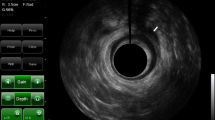PURPOSE: This study was designed to estimate the prevalence of anal sphincter injury after forceps delivery in a large population of females managed by trained obstetricians in a French hospital and to identify factors predictive for anal sphincter injury. METHODS: We performed a prospective study of healthy females older than 18 years with no history of anal incontinence, anorectal abnormalities, or anorectal surgery after their first vaginal delivery. All females were interviewed using a standardized questionnaire concerning intestinal transit and continence status. Physical examination and endoanal ultrasonography were performed after delivery. RESULTS: Between November 1999 and November 2000, 93 females were included in the study after their first forceps delivery. Eleven patients (11.8 percent) had a partial defect involving the external sphincter, visible on ultrasonography. One patient (1.1 percent) had a partial defect of external sphincter with complete defect of internal sphincter (sequelae of primary repair of a third-degree perineal tear). Seventeen patients (18.2 percent) had flatus incontinence, and four patients (4.3 percent) had liquid stool incontinence. A high daily number of stools was significantly associated with sphincter defect visible on ultrasonography (P = 0.02). The development of anal incontinence was not related to sphincter defect on ultrasonography. There was a strong association between perineal tear and sphincter defect visible on ultrasonography (odds ratio, 4.5 (range, 1.2–16.7)). CONCLUSIONS: Anal sphincter injury after forceps delivery was identified in <13 percent of our large population of healthy females. Our study does not confirm previous observations that anal sphincter injury is common after forceps delivery; previously published studies may have overestimated the prevalence of this condition. The only factor with significant predictive value for anal sphincter injury was perineal tear. Anal endosonography should be recommended after obstetric perineal tear.
Similar content being viewed by others
Author information
Authors and Affiliations
Corresponding author
About this article
Cite this article
de Parades, V., Etienney, I., Thabut, D. et al. Anal Sphincter Injury After Forceps Delivery: Myth or Reality?. Dis Colon Rect 47, 24–34 (2004). https://doi.org/10.1007/s10350-003-0007-8
Published:
Issue Date:
DOI: https://doi.org/10.1007/s10350-003-0007-8




